Our Blog
Rob's Travel Notes
A few of my favourite Italian places from France to Barbaresco in Piedmont
What I like most about spending time in France – my ‘home base’ in Europe – is that it's only two hours from Italy! I catch the afternoon Singapore Airlines flight to Paris, to arrive early next morning.
Then the TGV fast train to Lyon – it takes just two hours to go five hundred kilometres - which connects to the regional train to Beaune where a car is waiting. The first decision then is: lunch in the town, or head home to unpack and prepare to drive to Piedmont in northern Italy?
Road trip!
Invariably, I can’t wait to head across the border! There are at least three ways to get to our Piedmont destination – Barbaresco – from Beaune. Two are by tunnel – the Frejus via Mondane in France, and the Mont Blanc tunnel via Chamonix. Both are easy to get to, around the same length (12 kilometers), but Frejus is the more picturesque route. A slightly longer but above ground route is via the beautiful town of Annecy and cuts through the outskirts of Geneva.
Aosta
Once in Italy, one can stop off for afternoon tea in Aosta, a once-important Roman settlement that retains a charming historic centre. Similar to Switzerland, in a way, Aosta makes really good white wine – pretty well all chardonnay, not Petite Arvine and Chasselas as in Switzerland. (Look for the Anselmet or Les Cretes labels if you enjoy robust, citrus and nut-flavoursome styles).
Barbaresco
Within an hour you slide past Torino, going on an excellent and usually almost empty motorway, and then past beautiful Alba and into the Langhe Hills that surround it. Barbaresco is a village of around 800 people but has a fair bit of hospitality to enjoy. For example:
Koki Wine Bar – a wine shop specialising in Barbaresco by the glass, plus antipasto dishes.
Casa Boffa – an excellent wine bar (which also has accommodation).
Enoteca Regionale del Barbaresco – a government-owned and run centre for regional wine (and the place to go for a whole host of good value Barbaresco by the glass).
Gaia – the winery of one of Italy’s greatest Barolo and Barbaresco producers (not very accessible).
Torre di Barbaresco – a cheerful Trattoria, at the end of the ‘high street’.
About five minutes walk away is Locanda Rubaya! My favourite accommodation and restaurant (particularly in white truffle season!)
Monthelie
Situated in historic Monthelie, the house is a short walk from Meursault, and 7km from Beaune. Features include a heated pool overlooking the vineyards, a sun lover's terrace (with sunbeds), an al fresco outdoor dining area and an ancient coach house which we have converted into a summer house. The cottage is equipped for food and wine-loving visitors and has secure parking on site. To learn more about the property, click below to go to our website.
We also offer our guests and Compagnia Club members advice on how to plan a fabulous wine trip to Italy!
Rob
A Mudgee Winter Wonderland
A vigneron's view

Winter came early this year. Our first frosts were in the first week of May, and as I write this newsletter – we’re up to around twenty frosts...
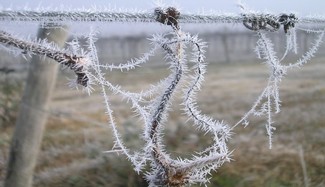
Despite this number (my benchmark to start pruning), the combination of the soaking vineyards from vintage 2022 and the fact that most frosts have been light, the juice has only now stopped flowing.
Our vines are mostly around twenty years old and show their age in damaged or missing cordons (the horizontal ‘arms’ that extend out from the trunk). So before manual pruning begins, we are repairing broken cordons achieved by laying a convenient cane from last year along the wire.
In a very short time – by next March - the extension will be fruit-bearing. Painstaking work, but necessary if one wants future crops to make up for the inevitable reduction in productivity caused by aging vines. By the end of the day in the vineyard, the body is tired and the fingers numb.
This is quite a neat segue into this blog’s wine feature...
Vin Brulé
...Which is vin brulé – Italian sweet and spiced hot mulled wine made with red wine and orange juice that puts the body back into order. There are various types of mulled wine served around the world – vin chaud in France, gluhwein in Germany – so here’s the mulled wine from Italy. Their recipes are remarkably similar!
If you like it a bit sweet, pick one that says ‘Semisecco’, ‘Amabile’ or ‘Dolce’ on the label. If you like it dry, look for the words ‘Secco’ on the label (with this style the flavours are more rhubarb or strawberry). Lambrusco di Sorbara and Lambrusco Rosato (rosé) are the two lightest styles, showing strawberry, and very little or no tannin).
The Recipe
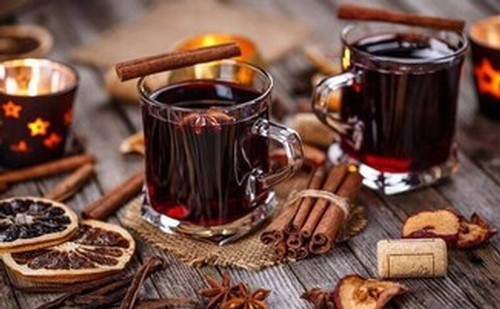
Prep Time: 15 minutes
Serves: 6
Calories: Not available!
Ingredients
750 ml red wine (Barbera, Cannonau or Lagrein*)
120 g sugar
1 orange
2 cinnamon sticks
2 star anise pods
10 whole cloves
*My choice would be a fruit-forward (as opposed to savoury) wine that is not aggressively tannic. But it’s your palate, and no wine would necessarily be out of bounds.
Instructions
Thinly peel the orange using a vegetable peeler to get as little as possible of the white bitter part. After that, cut the orange in half and squeeze it. Transfer the orange juice and peel to a saucepan.
Add the sugar, cinnamon sticks, cloves and one glass of wine (about 150 ml) and bring to a boil, constantly stirring to dissolve the sugar.
When the mixture reaches boiling temperature, add the star anise pods and the rest of the wine and keep it on the stove until it steams but does not boil. Remove from the heat just before it reaches boiling temperature. Serve hot.
Notes
Serve hot, as soon as possible after preparing. If you cannot serve it immediately, keep it on the lowest possible heat to prevent it from reaching boiling temperature (you don't want to evaporate the alcohol!).
Vin brulé and food
In Italy, panettone is clearly the most popular food companion for brulé, especially around Christmas. But there are plenty of other popular matches amongst Italian foods. These would include gorgonzola gnocchi, cheese fondue, mixed nuts and gingerbread biscuits.
Cannonau
The fact that vintage 2022 was pretty dismal in Mudgee is no longer news. It has led to there being no 2022 Barbera from di Lusso. I’ll miss the fruity mouth feel and spicey palate that is so different from the savoury taste profile of Sangiovese.
So, with the help of friends down south around Mildura, I’ve ‘discovered’ Cannonau - a premium red wine in the style of Grenache - whose home is on the island of Sardinia. The Italian DOC system permits the production of several different styles of Cannonau. Because of the body of our first Cannonau release (due in July), and its twelve-month aging, ours would most closely resemble the top-quality ‘Riserva’ style.
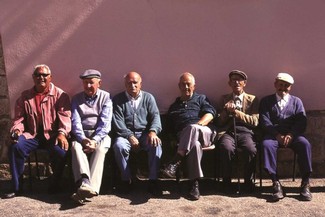
It’s estimated that one in five wines consumed in Sardinia is a Cannonau (and, I’d guess, another one in five could well be Vermentino!). Cannonau wines have attracted considerable attention in the last few years for their association with longevity. Sardinian locals tend to live well into their 90s and, in many cases, to over 100, and diet on the island is usually given as a key factor in this. Cannonau wine tends to be high in anthocyanins and polyphenols, antioxidant-rich compounds which have been linked to heart health.
Well, there you are!
Meet our Latest Wine!
Succo di Aleatico
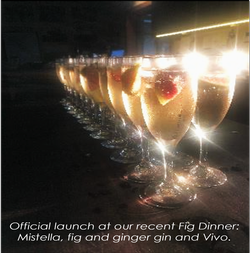
We are excited to introduce the newest addition to our di Lusso Estate range - Succo di Aleatico - a complex and intriguing mistella.
Succo di Aleatico is made from the juice of our Estate-grown Aleatico and barrel-fermented grappa.
Aleatico’s luscious candy flavours when blended with the grappa produce a 'wine' with a beautiful golden colour, late harvest flavours of apricot, marmalade and peach, and a spicy finish.
Not as sweet as a dessert wine, Succo di Aleatico can be enjoyed with baked desserts or after dinner with hard cheeses... or at any time, as a mixer - on ice, with di Lusso Estate Vivo! and lime.
Available now for $40 + shipping
Origins
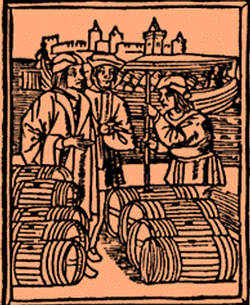
Mistella in some form, has been produced for over 300 years throughout the wine-producing regions of Europe, so there is some debate over its origins.
One theory is that Mistella was first developed by the Dutch to increase the shelf life of wine for transportation by ship (the addition of grappa would have killed any fungus or bacteria in the barrels).
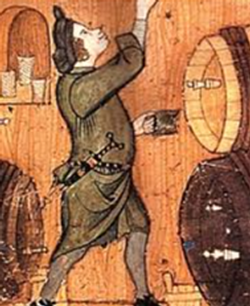
Another story goes that at some point in history, a careless worker at an unknown distillery or winery tipped some brandy into a barrel, not realising it was two-thirds full of juice, thus serendipitously creating the local aperitif. Versions of this happy accident are told in pretty much every mistella-producing region.
I am perhaps more persuaded that our heroic workers simply combined two delicious liquids in the age-old spirit of enquiry.
Suffice it to say that this style of drink has a long history in Italy, Spain, and some of France’s grape-growing regions (notably Cognac and Armagnac).
Winemaking
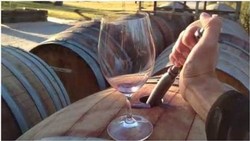 The Italian term Mistella, sometimes called Sifone, means the same thing as the French Mistelle and the Spanish Mistela: a mixture of grape juice and alcohol. Its claim to fame, as it were, is that the base juice does not undergo fermentation.
The Italian term Mistella, sometimes called Sifone, means the same thing as the French Mistelle and the Spanish Mistela: a mixture of grape juice and alcohol. Its claim to fame, as it were, is that the base juice does not undergo fermentation.
The Aleatico mistella was stored for three months in stainless steel tanks, and then wine spirit (grappa) was added. After that, we moved it into used French oak barrels. It rested for over two years.
From the very first time we tasted the blended wine, it was clear the flavours were interesting and unique! The final result is a tribute to creative winemaking and a special variety.
For our mistella, we chose the versatile Aleatico grape (which is also used in its raisined form in our Tuscan-style Vin Santo offering, Appassimento, in some of our Vino Rosato vintages, and of course, in our Aleatico wine itself).
Salute!
A Challenging Harvest
Harvest time
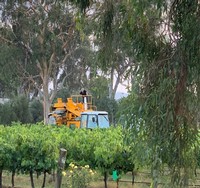
Before an enterprising American wine reviewer and writer named Robert Parker came on the scene in the 1970s, one couldn’t rely on ‘vintage reports’ for accurate assessments of the quality of a region's harvest.
Before his arrival on the scene, harvest reports were basically put out by the trade to sell wine. As I think about it, some still are!
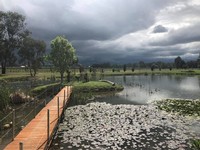
Rain and temperature are the two factors that will either make or break your vintage.
Neither were in our favour this year, with low spring temperatures and inconsistent but mostly very high rainfall experienced from September onwards - including, most recently, March.
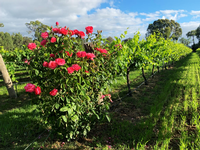
In summary, Sangiovese, Vermentino and Barbera suffered most, whereas our Nebbiolo, Lagrein, Arneis and Aleatico produced crops that though somewhat light, will produce good wines.
(I’m assuming a good outcome for Lagrein and Nebbiolo. As I write this report, it's bucketing down for the fourth day in a row. One more day’s rain, and I reckon we’ll have no reds at all in 2022!)
Elsewhere on the farm...
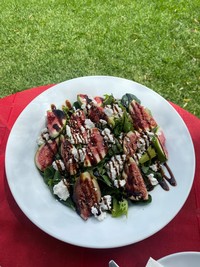
Our figs, on the other hand, after a late start have since early March been delivering beautiful fruit – which is now forming the basis of some lovely Autumn menu dishes (like our delicious Fig Salad!)
Fresh figs are also available for purchase from the Cellar Door.
And olives? What olives. After the bumper 2021 season, they’re having a rest, as they tend to do.
Our new release Vino Rosato

As I feared, our Sangiovese-based rosé from the 2021 vintage didn’t manage to last till the 2022 release – it was a very popular wine indeed. To make matters even more challenging, we have no 2022 Sangiovese fruit with which to craft its successor. (We make our rosé by using the French saigné method of ‘’bleeding” free-run juice from the base wine – in our case, Sangiovese - to arrive at a savoury, food-friendly wine rather than a fruity one.)
So instead, we decided to use a different method altogether by simply blending a 2021 Sangiovese with a 2021 Fiano post-fermentation (a practice which is actually prohibited in Europe — except for the making of rosé Champagne).
After adjusting slightly for sugar, we bench-trialled the result until we got close to the flavours and textures of the 2021 Vino Rosato of di Lusso Estate. This blended method will remain a fall-back option only.
Light at the end of the rainbow
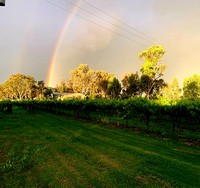
Despite the many challenges sent us by the weather and supply chain disruptions, we look forward to some great upcoming events at the Estate.
In addition to our Fig Dinner, we have our Concert and Canapes on Easter Sunday and plans for movie nights over the next few months. We will keep you posted!
Balance, flavour and mouthfeel
The three keys to wine.
Balance, flavour and mouthfeel are much used wine terms. Understanding what they are, and how they relate to one another, is a somewhat complicated but valuable exercise for anyone who enjoys wine. Let’s go!
Balance
 Simply put, a wine’s balance and mouthfeel describes how a finished wine demonstrates several key components of a wine - namely alcohol, tannin, acidity, sugar, the grape and the method used to make the wine (ie the winemaking). A well-balanced wine, each of these components will be ‘at peace‘with the others. Balanced wines are symmetrical and tend to age well.
Simply put, a wine’s balance and mouthfeel describes how a finished wine demonstrates several key components of a wine - namely alcohol, tannin, acidity, sugar, the grape and the method used to make the wine (ie the winemaking). A well-balanced wine, each of these components will be ‘at peace‘with the others. Balanced wines are symmetrical and tend to age well.
But there are two additional sensory components that turn a well-made wine into a must drink wine.
Flavour
 The first component is flavour. Each variety we work with has a flavour-signature. You can taste it by munching grapes in the vineyard. The salty Vermentino, the rosemary herby Sangiovese, the ‘spicy-cherry Barbera, etc. It is the job of the viticulturalist to deliver these ‘typical’ flavours to the winery.
The first component is flavour. Each variety we work with has a flavour-signature. You can taste it by munching grapes in the vineyard. The salty Vermentino, the rosemary herby Sangiovese, the ‘spicy-cherry Barbera, etc. It is the job of the viticulturalist to deliver these ‘typical’ flavours to the winery.
Then it’s up to the winemaker to elevate the fruit, at least into a ‘well-made wine’ but hopefully into “must-” drink’ territory.
Mouthfeel
The mouthfeel of a wine - the sensory perceptions experienced in the mouth when a wine is tasted- is key to achieving the migration. There are six components to the mouthfeel of wine:
Alcohol, Sugar and Water

Alcohol is a measure of how much fructose and glucose is converted in the fermentation process; residual sugar is a measure of how much natural wine sugar remains in the wine after fermentation and water is, well, water!
Length

Think about the after-taste of the wine. In mouthfeel language this is called length. Does it disappear quickly or do flavours linger? Which flavours stick around? Length doesn’t depend on the grape variety, the youth of the wine or the use of oak. They come from the slow release of flavour compounds in the wine. Generally, the ‘longer’ the wine, the more attractive.
This leaves us with two components - tannin and acid. These are tricky to define, but it’s the characteristics of each – and the relationship between them – that optimises the balance and overall attractiveness of a wine.
Tannin
Tannin is a naturally occurring group of compounds (called polyphenols), residing in the skins and seeds of (mostly) red wine grapes. Once the grapes have reached the winery, the way the tannins are extracted has a huge impact on the quality and character of the final wine.
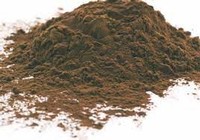
Effective tannin management releases a whole bunch of positive attributes in wine - colour stability, palate structure, producing astringency as a positive mouthfeel in a wine (as opposed to bitterness as a taste), and protect the wine against oxidation.
These are a group of compounds that are vitally important in wine, and more specifically red wines. From this stage on, the key to locking in wine quality is the rate of oxygen flows over the course of treatment.
As different chemical reactions involving oxygen take place, the phenols react to form polymeric species that enhance palate structure and colour stability in the wine., and also work to diminish excessively green, herbaceous characters and reductive aromas in the wine.
Acidity
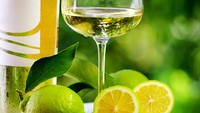
Acidity is a necessary structural component that balances sweetness, alcohol and the bitterness of tannins. Too much acidity can make a wine seem tart and light, while too little acidity can make a wine taste cloying and clumsy. Well-balanced acidity is the key to making a smooth, drinkable wine.
There are several different types of acid in wines. Malik (think apples) and citric (lemons) acid provide the mouth watering freshness that we very much favour at di Lusso.
Tartaric acid helps a wine age well. And finally, lactic acid (which is formed in the winery via a process called malolalactic acid fermentation) is that softer one that contributes roundness and richness to the mouthfeel. The most common is tartaric acid which as the name suggests is tart, but it is also a powerful antioxidant which helps a wine age, providing texture, ‘chewiness’ and depth.
Robert
Il Palio and the Super Tuscan Story
The di Lusso Estate il Palio wine is the only red blend in our portfolio. We’ve been producing it since 2002 – our first vintage. To some it’s seemed a bit ‘exotic’ – the use of Cabernet Sauvignon, a French varietal from Bordeaux as the base wine, then blending it with Italian reds, and its relatively rich fruitiness (as opposed the predominantly savouriness of most Italian reds) all made for an unusual point of difference.
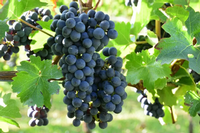
DNA evidence determined that Cabernet Sauvignon was the offspring of a chance mix of Cabernet franc and Sauvignon blanc, most likely as chance crossing that occurred in the 17th century.
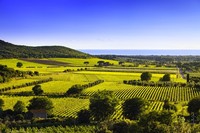
Within a hundred years the variety was widely grown in Italy - winemakers being convinced by its food friendliness, the less ‘sugary’ flavours it rendered to a bigger, richer blend. But also because to winemakers it offered up a ‘doughnut’ effect in the mid palate that encouraged other complementary varieties into the blend to “fill out the mid-palate”.
The style remained rare until the 1970’s, which saw a revolution in Italian winemaking. Following two decades post-war that saw in effect the disintegration of the Italian wine reputation, the government introduced an appellation system similar to that introduced into France in 1935.
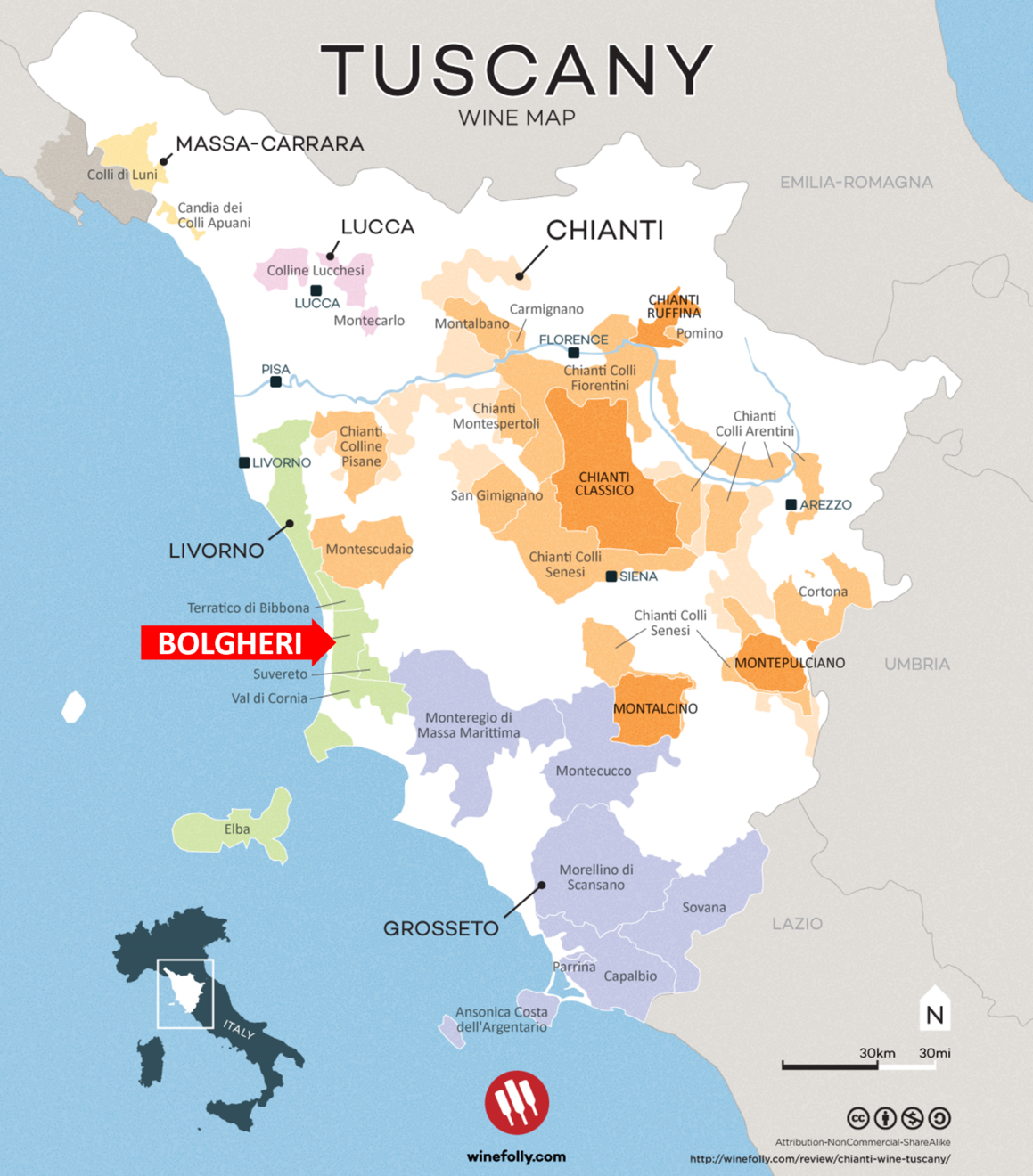
Each region and each varietal was carefully defined in every way – density of vines, use of water, use of oak, time before release, etc - to a degree of precision that didn’t appeal at all to a number of Tuscan winemaking ‘heavyweights’.

But the wine writers of the world became aware of the region. I maintain that the most influential of them all – Robert Parker – visited Bolgheri in the mid 1980’s and proclaimed in his Wine Advocate magazine, “These are not only Tuscan wines, they’re Super Tuscan”.
And so a new wine class was born. In 1992 the Italian government established an Appellation specifically for these wines – IGT or “Typical Geographic Indication".
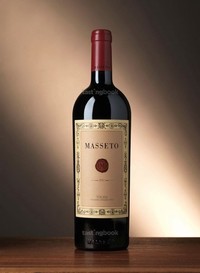
A rather silly title, but a hard-earned one. Today, they are some of the world’s most expensive wines. For example, the top of the range 2011 Masseto would cost $3700 a bottle; not far off the top Bordeaux or Burgundies of France.
Famous Bolgheri/Marremma producers include Antinori, Frescobaldi, and Angelo Gaya from Piedmont.
di Lusso Estate il Palio
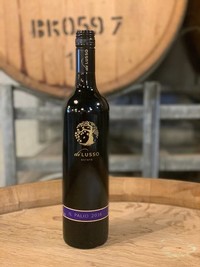
At di Lussso Estate, our 2016 Il Palio (named after the Italian tournaments commemorating historical events of the Middle Ages) is 80% Cabernet Sauvignon, 10% Sangiovese and 10% Barbera, with a cellar door price of $33.
Question: is the Masseto a hundred times better? Unfortunately, wine doesn’t work like that!

As an aside, in the 16th century the villa belonged to the Del Giocondo family. In 1505, Leonard da Vinci was commissioned to paint the wife of Francesco Del Giocondo.
The painting, formerly known as La Giaconda, is actually the famous portrait of The Mona Lisa, now preserved at the Museum of the Louvre in Paris.
The home of famous Bolgheri/Marremma producer Antinori, the Villa Antinori Di Monte Aguglioni.
Robert
The Sparkling Barbera of di Lusso
Origins
Italy produces more different kinds of sparkling wine than any other country in the world. In fact, they have been crafting spumantes since Etruscan times – prior to the Romans times, and long before Dom Perignon and his French brethren discovered it by mistake. The range of styles of Italian sparkling wines is enormous - from the light, off-dry Proseccos of the Veneto to the classic Franciacorta (the best of which I think rank alongside the wines of Champagne itself) – as is the number of different grape varieties used in its production.
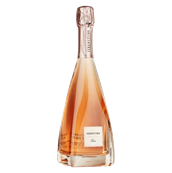
Franciacorta, of course, translates as ‘Short France’, and ever since Napoleon’s time has been using the methodé champenoise to make their sparkling wines, and still use French terminology to describe it (brut, rose, etc), and French varietals pinot noir and chardonnay as their varietals. This style has its own bottle shape. This is one favoured by Fanciacorta producers (and some of the more upmarket Proseccos).
But nobody seems to be able to tell me what it’s called!
The Charmat method
With the exception of the Franciacortas, most Italian sparkling wines – especially Prosecco - are made using the Charmat method. In this method, the wine’s second fermentation occurs in a pressurised stainless-steel tank instead of in the bottle, and the resulting wine is bottled young. There is none of the complexity and time - consuming process of ’real’ champagne. No riddling, no disgorging, no inconsistency in the final product, etc.
These are wines made in a hurry, to feed a market that is thirsty and cost-conscious. The best known of Italian sparkling reds is made from the Lambrusco grape, in an impressive range of styles.
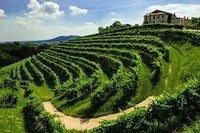
If you like it a bit sweet, pick one that says ‘Semisecco’, ‘Amabile’ or ‘Dolce’ on the label. If you like it dry, look for the words ‘Secco’ on the label (with this style the flavours are more rhubarb or strawberry). Lambrusco di Sorbara and Lambrusco Rosato (rosé) are the two lightest styles, showing strawberry, and very little or no tannin).
A typical prosecco vineyard, near the town of Conegliano in the Veneto. Rugged hills that have been tamed by hand-crafted vineyards.
di Lusso Estate Sparkling Wines
As of 2019, di Lusso Estate has joined the Italian Sparkling Club.

Our di Lusso Estate Vivacé, made from our own Barbera, grown on the estate has, in its short time on our tastings, become quite popular. We are expecting this wine to be a feature of the upcoming spring and summer, matched with charcuterie or cold duck, and served quite cold.
Our Vivacé is a spumante – sparkling wine – rather than a frizzante (semi-sparkling), The only example I could find in Italy of a bubbly Barbera is the Barbera Frizzante. The only one that I have tasted that I’ve tasted is more raspberry and fennel in flavour, and lighter in bubble as its name implies. (I must say, I prefer ours!).
We send our Barbera to Petersons in the Hunter to apply the ‘sparkle’. This they do using the Charmat method. The process isn’t cheap, but I’m yet to be disappointed in the end-product.
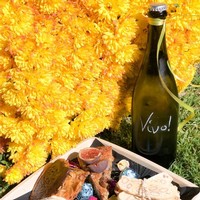
Both the Vivo (made using Vermentino or Arneis) and the Vivacé are both true to their Italian origins and to the summer life of Australia.
Salute!
Fantastic Figs!
Figs in one form or another have been on the planet for at least eighty million years.
Of course, its easy to stick around if there are more than 900 different species of you, which there are... But botanists have ascribed their longevity more to their characteristics than their range of varieties. To botanists, the winning factors are their universally beautiful taste, combined with their ‘accessibility’. No tough skin, for example.
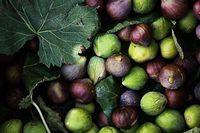
Figs attract the widest range of seed transporting animals in the whole of the plant kingdom. They are ecological linchpins, sustaining more wild birds and mammals than any other fruit tree on earth.
Figs are also the source of more myths and legends than any other fruit (or, more botanically correctly, a ‘false or multiple fruit', as the flowers and seeds grow together to form one gorgeous single ‘mass’).
Figs at di Lusso
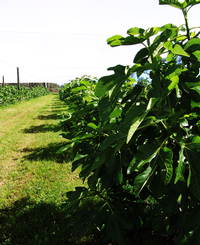 We grow five varieties of common fig at di Lusso Estate. All are female parthenocarpic varieties, and do not need pollination to produce fruit. So no need to deal with those little propagating wasps! Every year since 2003, my girls have performed the same ritual.
We grow five varieties of common fig at di Lusso Estate. All are female parthenocarpic varieties, and do not need pollination to produce fruit. So no need to deal with those little propagating wasps! Every year since 2003, my girls have performed the same ritual.
First, a showing of Black Genoa ripeness tells me it’s the second week of February.
A week later, it’s the turn of the White Adriatics (my favourite flavour, if I’m pushed to name one) to come to ripeness, with a more sustained season of six weeks or so. Meanwhile, my two lesser varieties Preston Prolific and Excel start moving.
Back comes Black Genoa with another season, then the mind-boggling champion of the orchard and juggernaut - Brown Turkey.
This lovely, patient variety is last to move, but more than makes up for this with a massive crop of around 1500 figs a tree that grows to the very top of the fig enclosure (or more than four metres). It is primarily the brown Turkey that keeps producing until the first frosts of May.
di Lusso Fig Products
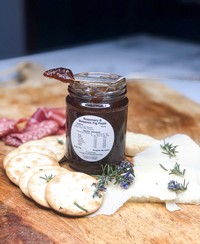
Steve Pavich, the Estate’s fig man, is out there almost every day, picking up to two thousand figs a day; sorting the crop between cellar door stock and crushed figs for ‘product’.
Product then moves under the control of Marcus Platt (one of several genii I’m blessed with at di Lusso) and who delivers a half dozen different flavours of fig pastes and vinaigrette (amongst much more farm produce) to the farmhouse door for our visitors.
And while all this is happening, the resident di Lusso spiders are ensuring the quality of the crop. I have never had to spray the figs in nearly twenty years, thanks to our golden orb weaver army that descends onto the trees as soon as the annual fig gnat plague begins early February.
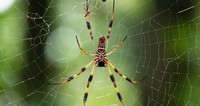
These magnificent spider-hunters grow from 5 mm (.2 of an inch) to 5 cm (2 inches) in a season – and end up comprised entirely of exactly what I don’t want to find on the crop. (The only disconcerting feature is their habit of building their nets across the inter-rows of the orchard; meaning that driving the ride-on mower becomes a very interesting, and gastronomic experience!
Robert
Arneis. The Re-birth of a Classic
Origins
This variety, native to the hillsides of the Roero near Alba in Piedmont, was a classic white table wine variety at least as long ago as 1350 AD. Over the centuries since, with its characteristic of zero tannin and pleasant perfumed aromatics, it became used more as a blending agent to reduce the notoriously fierce tannins of Nebbiolo…in particular the tannic brooding styles from the villages of Barolo and Barbaresco.
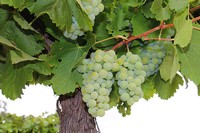
In the last eighty years or so, however, its usefulness as a blending agent to modify the ‘aggression’ of Nebbiolo further declined. Producers started using other methods of bringing the drinkability of Nebbiolo forward by a decade or more – from up to twenty years down to around five or so. Only a couple of producers (including notably Vietti, another favourite of ours) didn’t lose faith in it as a varietal white table wine.
Grapes contain thousands of tannic compounds, known as phenolics. Most of the tannins are in the skins and seeds, and they are extracted during the winemaking process. They are an excellent natural preservative, and give the wine structure. But some are harsh and bitter; and some taste "green" or unripe. Techniques such as micro-oxygenation (for tannins) and malolactic fermentation (for harsh acidity) became standard in the industry in the second half of the twentieth century, and wholesale replacement of Arneis with Barbera and Nebbiolo occurred.
Folklore has it that Arneis retreated to two vineyards, when someone asked the question, “What do think this tastes like as a table wine?” And of course, as they say, the rest is history.
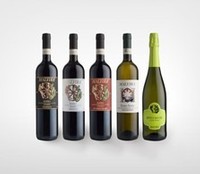
Our favourite Arneis producer, Malvira, has certainly taken advantage of this renewed popularity. Their winery, just a stone’s throw from the village of Barbaresco, produces FIVE different wine styles from the Arneis grape – a ‘regular’ dry white and a premium of the same vintage, a sparkling Arneis, an Arneis rosé and a vin santo style!
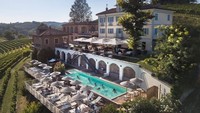
The fifty-meter strip of lawn from Malvira’s winery to the vineyard, when we visited there in 2009, was lawn. Today, their website features a luxury boutique hotel – complete with a magnificent swimming pool.
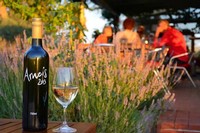
At di Lusso Estate, we planted just over an acre of Arneis on our Brambletyne site. Despite the variety’s reputation as being ‘tricky in the vineyard’, our experience is positive. And equally so in the winery, with a succession of good wines that provide the basis for our Vivo! bubbly.
Rob
2020... The year that was.
It didn't start well, did it?
Travelling to Mudgee town for my morning coffee and Sydney Morning Herald in thickening smoke from the first day of the New Year, I consoled myself with the twin thoughts that ‘the fires’ were still a hundred or more kilometres away and surely unlikely to damage the grape crop from that far off, and secondly we were off the mid-March for our annual trip to Europe. Earlier than usual, just in case the rumours of a dangerous virus from China was heading our way later in the year...
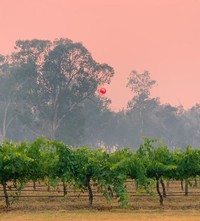 Well, we all know what happened. Sneaking out of France a day before all flights were cancelled – thanks to Qatar Airways, after Qantas and others had abandoned us! Straight back into reports that the 2020 grape crop was almost certainly non-existent (we had already lost the 2020 olive harvest due to huge hot winds in November that had literally burnt to death every flower in the grove), entire ‘lock down’ of di Lusso Estate’s commerce, and nobody willing or able to venture a guess as to when things might open up again.
Well, we all know what happened. Sneaking out of France a day before all flights were cancelled – thanks to Qatar Airways, after Qantas and others had abandoned us! Straight back into reports that the 2020 grape crop was almost certainly non-existent (we had already lost the 2020 olive harvest due to huge hot winds in November that had literally burnt to death every flower in the grove), entire ‘lock down’ of di Lusso Estate’s commerce, and nobody willing or able to venture a guess as to when things might open up again.
As I write, thanks mostly to our ‘lockable’ borders and judicious crisis management were still in the game – and thanks to the people of New South Wales for discovering in hordes the vineyards of Mudgee, we finished the rest of the year in good shape. Apart from a shortage of wine to sell at cellar door – due not to our tanks being empty, but rather to the very extended supply lines from interstate of bottles, printing ink, mobile bottling facilities etc, we were in business still. And now I can report that, thanks (I’m using that word a lot lately!) to hard work from the team, our shelves are full again!.
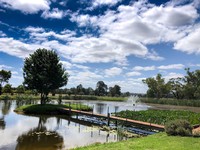
We bottled 2019 Pinot Grigio and 2020 Arneis this week (along with a Rosso version of Sangiovese, the excellent 2019 Nebbiolo and Lagrein), the last of the 2016 il Palio blend– for release next week.
Our new Vivo! bubbles arrived from the Hunter last week, too. So, dear Members, di Lusso Estate stands ready to once again be able to offer a ‘Full Portfolio’ (just the Aleatico is missing, and we currently working at filling that gap with a limited range of earlier vintage Aleatico).
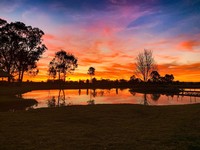
Our plan at this stage is to let the new arrivals overcome any initial ‘bottle shock’ they may have, and to offer a Summer Members’ Special sometime in January. In the meantime, the newly bottled wines are ‘in stock’. I’d just suggest waiting a week or two before opening one up!
I’m sure you’ll join me in bidding the ‘challenging’ 2020 farewell, and here’s hoping for a more settled 2021.
'Buon Natale'